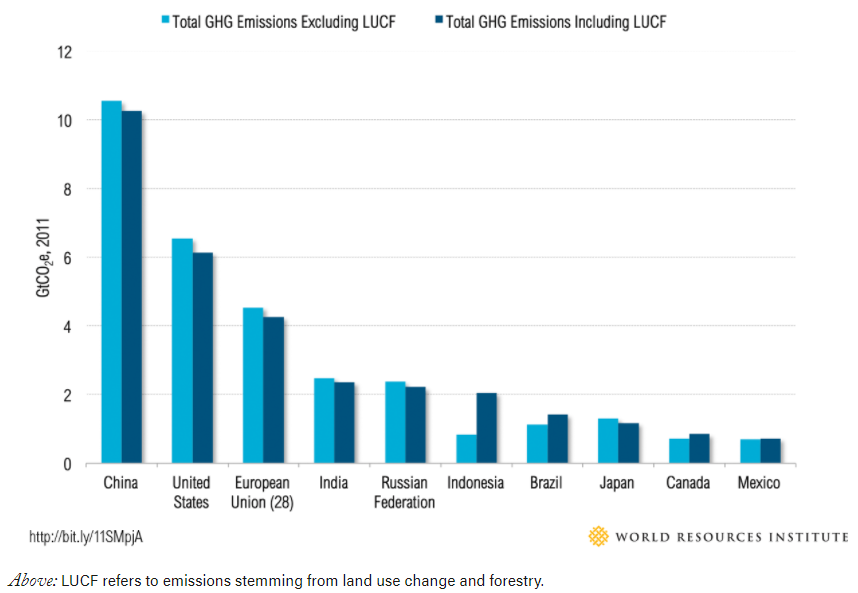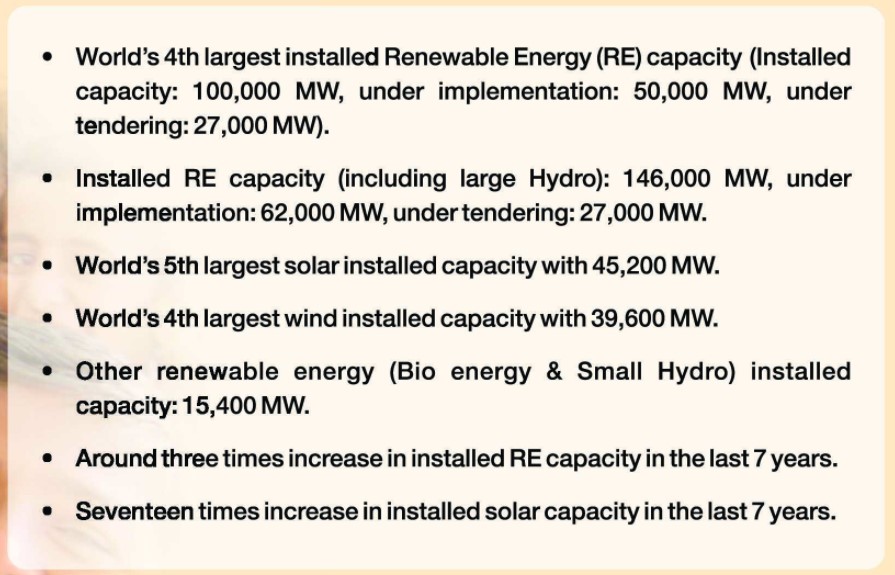CARBON NEUTRALITY BY 2070
2021 NOV 22
Mains >
Environment & Ecology > Global warming > Climate treaties and protocols
IN NEWS:
- At the 26th Conference of Parties (CoP26), Prime Minister Narendra Modi declared that India will reach carbon neutrality by 2070.
CARBON NEUTRALITY:
- Carbon neutrality means having a balance between emitting carbon and absorbing carbon from the atmosphere in carbon sinks.
- Net zero targets are a critical measure to successfully tackle climate change and its devastating consequences. According to the IPCC, global emissions must halve by 2030 and reach Net Zero by 2050 to stay below 1.5°C rise in temperature.
- Accordingly, the Organization for Economic Cooperation and Development (OECD) countries have declared a Net Zero target for 2050 and China for 2060.
INDIA’S COMMITMENTS:
I. Under Paris Climate agreement:
- Reduce emission intensity by 33 to 35 percent by 2030 compared to 2005 levels
- Produce 40 percent of electricity from non-fossil fuel-based energy resources by 2030.
- Create additional carbon sink of 2.5 to 3 billion tonnes of carbon dioxide equivalent by 2030 through additional forest and tree cover.
II. During CoP 26:
- During his speech at CoP 26, PM Modi presented a five-point 'amrit tatva' from India on climate change, terming the commitment as 'panchamrit':
- Increase non-fossil energy capacity to 500 GW (gigawatts) by 2030.
- Meet 50 percent of energy requirements from renewable energy (RE) by 2030.
- Reduce the total projected carbon emissions by 1 billion tonnes (BT) by 2030
- Reduce the carbon intensity of the economy by less than 45 percent.
- Achieve net zero carbon by 2070.
INDIA’S EMISSION STATUS:
- Absolute emission:
- India is the third largest carbon emitter after China and the US. (Fourth largest if the European Union is included).
- Coal power plants, rice paddies and cattle are major sources of emissions.

- Cumulative emission:
- Cumulative emissions describe a country’s total historic emissions. They are a commonly used concept for understanding responsibility for climate change.
- India's contribution to climate change in the last 200 years has been only three per cent.
- Per capita emission:
- India has per capita emissions of about 2.47 Tco2e (tonnes of carbon dioxide equivalent), as compared to the global average of 6.45 tco2/per capita.
- India has the lowest per capita emissions of the world’s major economies - emitting 5% of the total, despite accounting for 17% of the world’s population.
- Emissions Intensity:
- Emission intensity is defined as the total amount of greenhouse gas emissions emitted for every unit of GDP. India's GHG-emission intensity declined by 21% in 2014, from 2005 levels.
SIGNIFICANCE OF INDIA’S DECLARATION:
- Reaffirms India’s commitments:
- Despite not being a historical contributor to the greenhouse gas emissions, India has taken up the ambitious target. This clearly highlights India’s commitments towards combating climate change in general and Paris agreement in particular.
- Encourages developed world to act:
- At the 2009 Copenhagen climate talks, the developed nations promised USD 100 billion a year in climate finance to developing nations by 2020. But that goal has not been met.
- Now with India proposing a definite target, pressure will be on the developed countries to provide adequate climate finance to attain the target.
- Facilitates financial support:
- Committing to a legally binding net-zero target would help India attract some of the trillions of dollars in investment that will be required for a green transformation.
CHALLENGES:
- India’s developmental interests:
- No country has managed to ensure reasonable levels of wellbeing for its people without increasing energy supply.
- Given India’s development state and its efforts to lift large shares of its population out of poverty, the country needs to add more to its energy capacity, which poses a challenge to reducing reliance on fossil fuels.
- Challenge to industrialization:
- India is actively pushing for industrialization through efforts like Make in India and product linked incentive scheme. Hence, India’s emissions from making steel, cement, chemicals and other carbon-intensive materials are set to rise, which can pose a challenge to the climate push.
- Question over coal:
- Coal is used for almost 70% of power generation. Reaching the goal of net-zero greenhouse gas emissions by 2070 for India would mean an overhaul of a coal-reliant energy sector. However, India has not made any clear commitments on cutting down coal.
- Access to finance and technology
- India’s climate actions will depend on climate finance, be it for adoption of clean technology, decarbonisation or resource efficiency. It needs to be seen whether the resources wil be made available by developed countries.
- Unjustifiable burden on developing world:
- Despite being the largest contributors, developed countries have a poor track record on climate action. In this light, the immense pressure on developing countries like India to declare net-zero pledges goes against the idea of common but differentiated responsibilities.
SOME KEY INITIATIVES BY INDIA:
- National Action Plan on Climate Change (NAPCC), 2008
- The Government of India launched National Action Plan on Climate Change (NAPCC) on 30thJune, 2008 outlining eight National Missions on climate change. These include:
- National Solar Mission
- National Mission for Enhanced Energy Efficiency
- National Mission on Sustainable Habitat
- National Water Mission
- National Mission for Sustaining the Himalayan Eco-system
- National Mission for a Green India
- National Mission for Sustainable Agriculture
- National Mission on Strategic Knowledge for Climate Change
- National Initiative on Climate Resilient Agriculture
- Launched by Indian Council of Agriculture Research (ICAR), NICRA aims to make farmers self-reliant by use of climate resilient agricultural technologies and management of resources for sustaining agriculture in the era of climate change.
- Push for renewables:

- Pradhan Mantri Ujjwala Yojana (PMUY) and Ujjwala 2.0:
- Ujjwala seeks to provide free LPG connections to 5 Cr BPL households to reduce their dependence on the polluting cooking fuel.
- Ujjwala 2.0 aim to provide deposit-free LPG connections to those low-income families who could not be covered under the earlier phase of PMUY.
- FAME India:
- Faster Adoption and Manufacturing of (Hybrid &) Electric Vehicles in India (FAME), launched in 2015, is launched to support hybrid/electric vehicles market development and Manufacturing eco-system.
- Phase II of FAME is targeting a fully (100%) electric fleet for public transport.
- Har Medh Par Ped
- Under the scheme, agro forestry is being promoted for supplementing farm income, increase risk management and climate resilient agriculture as an important component of Integrated Farming Systems.
- Energy Conservation Building Code (ECBC), 2017:
- Developed by Power Ministry and BEE, ECBC seeks to promote low carbon growth by integrating the renewable energy sources in the design of the buildings.
- Green Rating for Integrated Habitat Assessment (GRIHA):
- Developed by TERI as a national rating system for buildings, it evaluates the environmental performance of a building holistically over its entire life cycle, thereby providing a definitive standard for what constitutes a green building
- Green Skill Development Programme
- It was launched in line with the Skill India programme for skilling India’s youth in the environment and forest sector.
- It seeks to develop green skilled workers having technical knowledge and commitment to sustainable development, which will help in the attainment of the Nationally Determined Contributions (NDCs), SDGs, National Biodiversity Targets (NBTs), as well as Waste Management Rules (2016).
WAY FORWARD:
- Develop a roadmap: The country now needs to lay out a clear road map for how it will achieve net zero and establish monitoring mechanisms to ensure that emissions are falling.
- Ensure inclusive growth: India must ensure that growth is equitable and that the poor in the country are not denied their right to development in this new energy future.
- Enhance access to cleaner energy: India must work on the increasing clean, but affordable, energy for the poor. India would also need to step up its push for renewables and electric mobility.
- Develop plans to phase out coal: For India to attain the target of net zero, the country will require phasing down coal-based power from the next decade onwards.
PRACTICE QUESTION:
Q. The success in combating climate change will be determined not only by the extent of global action, but also by what we achieve locally. Discuss the statement in the light of India’s efforts towards combating climate change?

